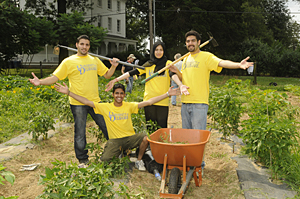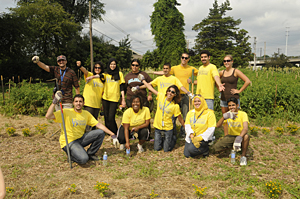

- Rozovsky wins prestigious NSF Early Career Award
- UD students meet alumni, experience 'closing bell' at NYSE
- Newark Police seek assistance in identifying suspects in robbery
- Rivlin says bipartisan budget action, stronger budget rules key to reversing debt
- Stink bugs shouldn't pose problem until late summer
- Gao to honor Placido Domingo in Washington performance
- Adopt-A-Highway project keeps Lewes road clean
- WVUD's Radiothon fundraiser runs April 1-10
- W.D. Snodgrass Symposium to honor Pulitzer winner
- New guide helps cancer patients manage symptoms
- UD in the News, March 25, 2011
- For the Record, March 25, 2011
- Public opinion expert discusses world views of U.S. in Global Agenda series
- Congressional delegation, dean laud Center for Community Research and Service program
- Center for Political Communication sets symposium on politics, entertainment
- Students work to raise funds, awareness of domestic violence
- Equestrian team wins regional championship in Western riding
- Markell, Harker stress importance of agriculture to Delaware's economy
- Carol A. Ammon MBA Case Competition winners announced
- Prof presents blood-clotting studies at Gordon Research Conference
- Sexual Assault Awareness Month events, programs announced
- Stay connected with Sea Grant, CEOE e-newsletter
- A message to UD regarding the tragedy in Japan
- More News >>
- March 31-May 14: REP stages Neil Simon's 'The Good Doctor'
- April 2: Newark plans annual 'wine and dine'
- April 5: Expert perspective on U.S. health care
- April 5: Comedian Ace Guillen to visit Scrounge
- April 6, May 4: School of Nursing sponsors research lecture series
- April 6-May 4: Confucius Institute presents Chinese Film Series on Wednesdays
- April 6: IPCC's Pachauri to discuss sustainable development in DENIN Dialogue Series
- April 7: 'WVUDstock' radiothon concert announced
- April 8: English Language Institute presents 'Arts in Translation'
- April 9: Green and Healthy Living Expo planned at The Bob
- April 9: Center for Political Communication to host Onion editor
- April 10: Alumni Easter Egg-stravaganza planned
- April 11: CDS session to focus on visual assistive technologies
- April 12: T.J. Stiles to speak at UDLA annual dinner
- April 15, 16: Annual UD push lawnmower tune-up scheduled
- April 15, 16: Master Players series presents iMusic 4, China Magpie
- April 15, 16: Delaware Symphony, UD chorus to perform Mahler work
- April 18: Former NFL Coach Bill Cowher featured in UD Speaks
- April 21-24: Sesame Street Live brings Elmo and friends to The Bob
- April 30: Save the date for Ag Day 2011 at UD
- April 30: Symposium to consider 'Frontiers at the Chemistry-Biology Interface'
- April 30-May 1: Relay for Life set at Delaware Field House
- May 4: Delaware Membrane Protein Symposium announced
- May 5: Northwestern University's Leon Keer to deliver Kerr lecture
- May 7: Women's volleyball team to host second annual Spring Fling
- Through May 3: SPPA announces speakers for 10th annual lecture series
- Through May 4: Global Agenda sees U.S. through others' eyes; World Bank president to speak
- Through May 4: 'Research on Race, Ethnicity, Culture' topic of series
- Through May 9: Black American Studies announces lecture series
- Through May 11: 'Challenges in Jewish Culture' lecture series announced
- Through May 11: Area Studies research featured in speaker series
- Through June 5: 'Andy Warhol: Behind the Camera' on view in Old College Gallery
- Through July 15: 'Bodyscapes' on view at Mechanical Hall Gallery
- More What's Happening >>
- UD calendar >>
- Middle States evaluation team on campus April 5
- Phipps named HR Liaison of the Quarter
- Senior wins iPad for participating in assessment study
- April 19: Procurement Services schedules information sessions
- UD Bookstore announces spring break hours
- HealthyU Wellness Program encourages employees to 'Step into Spring'
- April 8-29: Faculty roundtable series considers student engagement
- GRE is changing; learn more at April 15 info session
- April 30: UD Evening with Blue Rocks set for employees
- Morris Library to be open 24/7 during final exams
- More Campus FYI >>
8:52 a.m., July 14, 2009----As Sara Sabt worked in the University of Delaware's Garden for the Community, helping to raise food for families in need, she was thinking about how much her mother enjoys tending her own plants back home -- some 6,500 miles away in the Middle East.
Sabt was among a dozen or so volunteers who came out to the College of Agriculture and Natural Resources' 15,000-square-foot plot on Saturday, July 11, to pull weeds between the neat rows of fledgling plants and harvest some early vegetables for donation to the Food Bank of Delaware. A third-year information systems student in her native Bahrain, she said she hopes to be a business executive or an academic, not a gardener, but that she loves the opportunity to experience all aspects of American life.
“I wanted to come to the United States and learn about leadership, which I think will help me in my career,” said Sabt, who is participating in a program at the University this summer that is supported by the Middle East Partnership Initiative. “But I also wanted to learn about the lifestyle in the United States and meet Americans. We've had the chance to talk to students here and discuss what they think about the Middle East. They've had some misconceptions, but everyone has been really nice to us, and I think we've all learned a lot about each other.”
The initiative, known as MEPI, was founded in 2002 by the U.S. State Department to provide college students from the Middle East and North Africa with the chance to study American culture and politics during an intensive, six-week stay in the United States. UD was chosen this year for a record sixth time to be one of the locations for the program, which is implemented and administered locally by the University's Center for International Studies.
The 18 students arrived in late June to begin the Undergraduate Institute on American Studies and Leadership at UD, taking classes in such subjects as political science, communications and leadership. Representing 17 countries, from Israel to Syria to Morocco, they said they are learning not just about America but also about one another.
“As soon as we were here for a few days, it was like we were friends for years,” said Jacoub Sleibi, a Palestinian who is studying computer science and business administration at Bethlehem University and said he was thrilled to be selected as a MEPI participant for his first visit to the United States. “The best part of the classes we take here is not the lectures but the interaction and the discussions.”
Because the program this year has expanded its civic engagement component, the students at UD are helping with several community service projects. On Saturday, 10 members of the group worked in the Garden for the Community, while the others joined in a Habitat for Humanity construction project.
“We discussed hunger and homelessness in the United States, so projects that benefit the Food Bank and Habitat relate to that,” said Sendy Guerrier, a UD graduate student who is assisting with the summer program. “I met with the students and gave them some background to help put those issues in perspective.”
The garden itself is a new program this year in which all the produce being raised will be donated to the Food Bank. Project coordinator Alyssa Collins, who earned her doctorate in plant science in 2006 and now is a postdoctoral researcher in plant pathology, said the goal is to supply Delaware families in need with 3,000 pounds of fresh vegetables, fruits and herbs.
For the past few years, graduate students in the College of Agriculture and Natural Resources have used the one-third-acre plot on the UD Farm to grow their own produce and then donated any surplus to the Food Bank. But this year, Collins said, Tom Sims, associate dean of the college, proposed dedicating the garden's full production to the nonprofit that supplies food to those in need.
“We decided this was a much more efficient way to help address hunger in Delaware,” Collins said. She oversees a contingent of volunteers from throughout the University, who benefit from the advice and assistance of the Master Gardeners program run by Cooperative Extension. On any given day, the volunteers are likely to be a mix of expert home gardeners, novices and a range of experience levels in between.
The plot has been planted in tomatoes, peppers, beans, okra, pumpkins and squash, among many other crops. In addition to the donated plants, some “volunteer” tomatoes and watermelons have sprouted on their own. Those are holdovers from previous years, Collins said, adding, “This garden is full of volunteers -- plants and people.”
The Food Bank, which traditionally relies on donations of canned goods and other nonperishable items, has welcomed the addition of more homegrown produce to distribute this summer and into the fall, Collins said.
“Fresh food is natural and nutritious,” she said. “We think that's especially important for children, and we understand that 30 percent of the Food Bank's clients are children.”
Sims said the Garden for the Community “represents the core mission of the College of Agriculture and Natural Resources -- helping to feed the world in a sustainable manner.”
Sims added, “We are privileged to manage UD's 350-acre agro-ecology teaching complex and very happy to provide this land so that our students and community partners can help the Food Bank meet its mission, a community without hunger.”
The project is a partnership of the college, the Master Gardeners program, the state Department of Agriculture and others in the community. For more information or to volunteer, visit the Garden for the Community Web site.
Article by Ann Manser
Photos by Duane Perry


